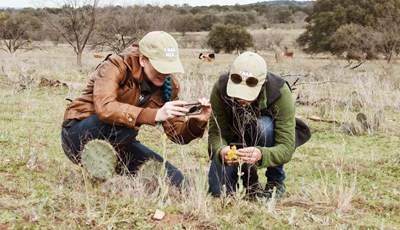Resources for New Landowners: Soil Management
Private Land Stewardship is a core component of our mission at NRI, and our goal is to provide landowners with the resources they need to better care for their land. For new or future landowners, the best time to gather knowledge and information is before making management decisions that will have lasting effects on the land. Thinking of well-managed land conjures up images of lush, green fields and healthy wildlife populations, but it is important to stop and consider where it all begins - with the cultivation of healthy soils. In 2018, NRI wrote an article, “Private Land Stewardship Starts with Soils,” that pinpointed just why soils are so important and how they can impact management decisions. For the first article of our new blog series, “Resources for New Landowners,” we will revisit the importance of soils, and go more in-depth into the tools that are available to help us evaluate and understand soil.
Soil Testing
To understand soil, you have to know what’s in it. The Texas A&M AgriLife Extension Service Soil, Water, and Forage Testing Laboratory conducts soil tests to determine property-level characteristics about soil. Some of their current tests include determining soil pH, the proportion of nitrate-nitrogen (NO3-N), amount of micronutrients, salinity, and the presence of both organic and inorganic carbon. If you are unsure of how to collect a soil sample for testing, this video provides an excellent demonstration.
NRCS Ecological Site Descriptions
The United States Department of Agriculture’s (USDA) Natural Resources Conservation Service (NRCS) has developed Ecological Site Descriptions, an extensive list of reports which classify and describe soil and vegetation for sites across the nation. The four major components of an Ecological Site Description (ESD) include site characteristics, plant communities, site interpretations, and supporting information. Sites are differentiated from one another depending on difference in soil, vegetation, and overstory canopy (e.g. forestland vs. rangeland). ESDs can provide useful information about land use suitability, best land management practices, and sustainability necessities for landowners and land managers.
To locate an ESD, visit the Ecological Site Description System for Rangeland and Forestland Data. This page allows you to search for ESDs either by choosing your state or selecting a Major Land Resource Area (MLRA). If you don’t know your MLRA, you can use this mapping tool to locate it (please note: when searching for MLRAs by state/county, the mapping tool will often freeze so it is best to use other criteria). Take a look at this video for a quick look at how to utilize these tools.
Once you enter your search criteria, a table will provide you with a report link for each available ESD, accompanied by basic site information. Each will be listed as “provisional” or “approved”—provisional status represents a report that has passed the minimum requirements for public release, but will continue to be refined until it gains full approval and distinguishes the site characteristics in detail. Each ESD provides you with a map of the site, common plant species found in the area, and an “ecological site concept.” These concepts paint a picture of the soil structure and important characteristics which may impact management decisions. Elements such as the permeability, pH, nutrient and mineral content of the soil may alter the way you manage the land to encourage healthy flora and fauna.
NRCS Web Soil Survey
The NRCS also developed the Web Soil Survey (WSS), the largest natural resource information system in the world. The WSS compiles information from the National Cooperative Soil Survey to provide vividly detailed soil maps for more than 95% of the nation’s counties. The WSS interactive map provides you with multiple tools to narrow down the map to a specific Area of Interest (AOI) for which you are seeking soil information. This resource is designed to teach landowners everything they need to know about soil to properly understand it, sustainably utilize it, and thoughtfully manage their properties.
To help you learn how to navigate this tool, we will take a look at the following prompt:
Use Web Soil Survey to look up an example property in Stonewall County located at 33° 14’ 19.15” N | 100° 19’ 10.14” W. Determine the predominant soil type at the site, as well as the primary vegetation and any other relevant information. Watch this tutorial to see a step-by-step look at how to find this soil information, or attempt the problem on your own.
Conclusion
Each of these valuable resources was developed to help landowners understand the complexity of soil and make informed decisions about land management. If managers learn the importance of the soil on their land, they will see how it impacts vegetation growth, wildlife and livestock populations, and the future of the property. After learning from these resources, landowners will more clearly recognize the value in managing their land from the ground up - literally.
List of Soil Resources:
- NRI blog - “Private Land Stewardship Starts with Soils”
- Soil testing at the Texas A&M AgriLife Extension Service Soil, Water, and Forage Testing Laboratory
- Texas A&M AgriLife Extension video - “How to Take a Soil Sample”
- NRCS Ecological Site Descriptions and Ecological Site Description System for Rangeland and Forestland Data
- ESD & MLRA tutorial video
- Major Land Resource Area (MLRA) explorer
- NRCS Web Soil Survey (WSS) and WSS interactive map
- WSS tutorial video





